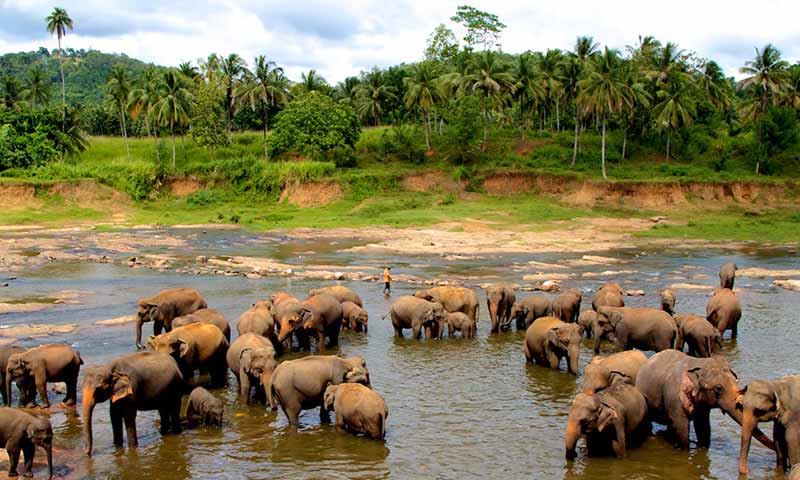
‘Hakkapatta’ found in Pinnawala
A few ‘hakkapatas’, a small handmade explosive device, were found hidden in a tree on the banks of Maa Oya, near the elephant bathing area in Pinnawala.
The Police suspect that they were hidden there to purposefully hurt the elephants while they were bathing. The person responsible for these is still unknown.
The explosives will be disposed of once the order comes from the Kegalle Courts. The Police are conducting investigations.
Source – 25/03/2017,Front page, See moreat – http://www.frontpage.lk/page/-Hakkapatta-found-in-Pinnawala/19655
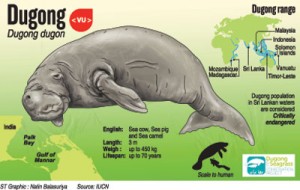
Threatened dugongs thrown a lifeline
The dugong is the most threatened marine mammal likely to disappear from our waters, but there are efforts to save the species.
Thirteen dugongs were killed last year, according an informal survey in the North Western coastal areas by marine activists. This is one dugong killed every month and considering their rarity, is worrying, says Prasanna Weerakkody of Ocean Resources Conservation Association.
“Through informal discussions with fishermen, we found out that one dugong had been trapped in a net. The fishermen knew it was illegal to pull it ashore and had it anchored under water to collect it when the navy is not around. But the carcass got loose and washed ashore,” revealed Weerakkody. There could be many other dugong deaths that go unreported, he said.The latest dugong deaths occurred December last year. A carcass was found on Nadukuda beach in Mannar. A few weeks earlier, another carcass washed ashore near Thavilpadu beach. Fishing activities using explosives are common in the nearby Vankalai Coral Reef and marine activists initially thought dynamite had killed the dugong found in Nadukuda.
Dugongs are also called mermaids of the sea because some sightings of mermaids are actually misidentified dugongs seen from afar
The dugong is also known as the ‘sea cow’ for its habit of grazing on the seagrasses on the ocean bed. Seagrass is different from seaweeds (which is an algae) and are actually more closely related to the flowering plants with roots, stems, leaves, flowers and seeds. Seagrasses can form dense underwater meadows and an adult dugong consumes as much as 45 kg seagrass according to experts.
Dugongs are vulnerable to extinction because they are killed directly or indirectly by human-related activities, which include fishing, coastal development and hunting. The seagrasses on which they depend are thought to be one of the most threatened ecosystems on Earth.
In 2015, the “Dugong and Seagrass Conservation Project” was initiated to improve protection and conservation of dugongs and their seagrass habitats around the world, said United Nation’s Environment Program (UNEP)’s Max Zieren who recently visited Sri Lanka. Indonesia, Madagascar, Malaysia, Mozambique, Solomon Islands, Sri Lanka, Timor Leste and Vanuatu is part of the project, which is the first coordinated effort, he added.
In Sri Lanka, the project focuses on the northwest region, namely the Gulf of Mannar and Palk Bay where dugongs have been recorded. The project is coordinated by the Department of Wildlife Conservation and eight other partner organisations are supporting.
Sugath Emmanuel, local fisherman and diver in Kalpitiya, said he had not seen a dugong alive. He recalled eating dugong flesh during his childhood, in an area where many dugongs were caught. The flesh was considered a local delicacy. Hundreds of dugongs were killed before it was outlawed in the 1970s. Now, about 90 percent of the dugong killings are accidental or by-catch. 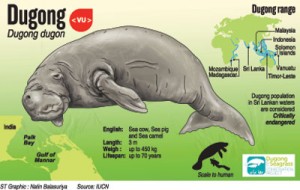
Dugongs are categorised as ‘vulnerable’ in IUCN’s threatened species list considering global populations, but they can be ‘critically endangered’ in Sri Lankan waters, says Arjan Rajasuriya, project manager of International Union of Conservation of Nature (IUCN). He has been diving for the past 30 years, but has yet to see a dugong alive.
IUCN’s responsibility in the project aims at establishing an additional 10,000 hectares of marine protected area in the Gulf of Mannar and Palk Bay. Rajasuriya says dynamite fishing should be halted.
The project also aims to raise awareness among people and also give incentives to abandon illegal fishing methods. Project partner, Sri Lanka Turtle Conservation Project, is seeking to reduce the negative impact of destructive fishing practices on seagrass habitats and provide income generation opportunities to local communities in return for their commitments for the prudent use of habitat and natural resources in the Puttlam lagoon.
The Biodiversity Education and Research NGO has taken on the education aspect of the project, especially targeting schools. Ranil Nanayakkara, who heads the group, says the response from school children has been positive.
The overall project is financed by Global Environment Fund Project and Mohamed bin Zayed Species Conservation Fund. The United Nations Environment Programme supports its implementation together with the Memorandum of Understanding on the Conservation and Management of Dugongs and their Habitats throughout their Range of the Convention on Migratory Species.
Dr Lakshman Peiris, who is the project manager of DWC, said the Wildlife Department was focused on addressing marine issues with the establishment of a special unit.
The Sunday Times also asked Peiris what will happen after the four-year project ends in 2018. “The project will give us lots of information. We will create a management plan and will make sure its implementation together with other strategic partners such as Department of Fisheries, Coast Conservation & Coastal Resources Management Department, and the Marine Environment Protection Authority. The Sri Lanka Navy and Sri Lanka Coast Guard can give us lots of support by monitoring and stopping illegal activities,’’ Peiris added.
Dugongs are also found in the Indian part of the Gulf of Mannar, but unfortunately India is not part of the project. Marine biologists say India too needs to get on board. Peiris of the DWC said plans are underway to increase coordination between two countries.
Marine biologists also stress the need for action, once a strategy to save the dugongs are made. “Since the dugong is a charismatic species, we can use activities geared to protecting it to also help us to provide a refuge for other threatened marine creatures,” marine expert Rajasuriya said.
Source – 26/03/2017, The Sunday Times, See more at – http://www.sundaytimes.lk/170326/news/threatened-dugongs-thrown-a-lifeline-234096.html
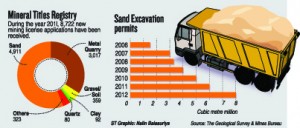
Building boom endangers sand and gravel resources
Sri Lanka’s lawmakers this week approved a proper mechanism to mine sand, gravel, and rocks from lands belonging to the Mahaweli Authority and Forest Department where applicable. The decision aims to ease the demand for these and other building materials.
A cabinet paper states that only lands that are not declared as ‘protected areas’ will be targeted and that mining be done only after an environmental assessment. But environmentalists say the remaining forests should not be vandalized.
The Environment Conservation Trust’s Sajeewa Chamikara says that as soon as the war ended, forests in the north were mined for soil, gravel, and rocks to provide materials for infrastructure such as roads. “This eventually led to a severe water shortage in some of the northern areas and the new approval of mining in forest areas could also lead to such a situation,” he warns.
Environmentalist Nayanaka Ranwella, points out the situation is worse in the Gampaha District in the Western Province. “There are a lot of mining activities as these building materials could be easily transported to Colombo due to the proximity. But these mines already contribute to water shortages in the area,” he said. He also says there are no licences for 80 per cent of the excavations. Even those who have licences excavate more than what is allowed.
Geological Survey and Mines Bureau Acting Director General, Sajjana De Silva, said the agency had cancelled more than 100 licences citing violation of conditions during the past few years. He said there are a number of unapproved excavations and that support from other agencies is needed.
He said the daily volumes needed to fill the central expressway exceeds the amount of gravel generated by all licencees.But as controls are tightened, it is creating shortages of building materials.Projects such as expressways and numerous high-rises in Colombo and elsewhere require massive amounts of natural materials.Experts says there is a construction boom in Sri Lanka.
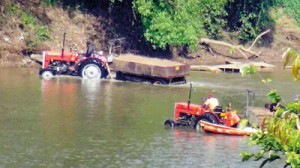
“Finding sand and other materials is the worst headache for contractors,” says the Chairman of National Construction Association of Sri Lanka, Athula Galagoda. He also says that the quality of the sand is poor.
Road Development Authority Chairman, Nihal Suriarachchi also says sourcing gravel for filling purposes is diffcult and it could affect expressway projects.
Sajeewa Chamikara of the Environment Conservation Trust suggests estimating the materials requirements and identifying ways of sourcing before projects are started.
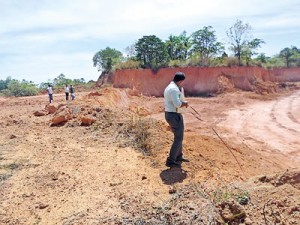
GSMB’s former chairman, Dr. N. P. Wijayananda, points out that most of the problems regarding gravel occur because the constructors or suppliers of soil and other material are looking for sources closer to construction sites. It will be cheaper to transport, but will carry a huge environmental cost.
“Find a feasible source of gravel in a central place, do the mining scientifically and transport to the construction site. Yes, the supplier will have to spend more for transport, but environmental damage will be much less,” Dr Wijayananda suggests.
The SundayTimes also asked Dr Wijayananda, what could be a possible solution. He suggests a three-pronged approach – opening up new deposits, using railways to reduce transport costs, and promote the use of sea sand.
He recalled that earlier the sand deposits at Manampitiya were opened up to meet urgent needs.
“The flow of the Mahaweli river causes sand to accumulate around the Manampitiya Bridge in Polonnaruwa, creating a flood plain around it. If we do not use this sand, they will anyway be washed to the sea. The next monsoon will replenish the sand deposits, so sand excavation in this area could be done sustainably,” Dr Wijayananda assures.
He reveals there are other sand deposits between Manampitiya and Trincomalee. But there are no proper access roads and it is not easy to transport from the sites.
“All these excavations have to be done under strict guidelines without deepening the river unnecessarily and without affecting the banks,” Dr Wijayananda said.
He also said that during his tenure at the Mines Bureau discussions were held with the railways on transporting materials, but that it was more expensive. “But if the government is willing, it can amend the rules facilitating cheaper sea sand transport by rail. I’m sure the cost of sand can be reduced by 40 percent,” he said.
Sea sand needs to be properly cleaned. “Europe extensively use sea sand for construction. We need to mechanically clean the sea sand and set standards of minimum salinity levels.”
Source – 26/03/2017, The Sunday Times , See more at – http://www.sundaytimes.lk/170326/news/building-boom-endangers-sand-and-gravel-resources-234121.html
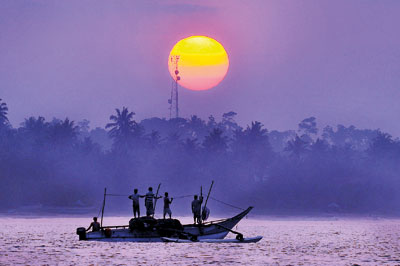
Earth hour: Let’s save our beautiful planet
At 8.30 pm yesterday, in Sri Lanka and worldwide, millions of people were called upon to switch off their lights to mark earth hour in a global celebration of their commitment to protect our planet, which is still beautiful though facing a possible catastrophe because of pollution and global warming. One of our planet’s most beautiful scenes is the sunrise and this picture taken by our photojournalist Amila Gamage from a boat at Mirissa shows this beauty which no painting can portray.
Source 26/03/2017,The Sunday Times, See more at – http://www.sundaytimes.lk/170326/news/earth-hour-lets-save-our-beautiful-planet-234239.html
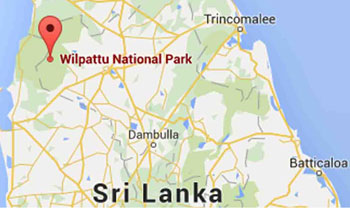
All forest reserves in Wilpattu North merged into one.
All the forest reserves belonging to the Department of Forest Conservation, located in the northern part of Wilpattu National Park, have been declared as a single forest reserve. Accordingly, Mavillu, Weppal, Karadikkudi, Marichchakatti, Withthikulam and Periyamuruppu have been combined in terms of the Forest conservation Ordinance and President Maithripala Sirisena signed the Gazette Notification today during his visit to Moscow. The President has advised to take necessary steps to preserve the adjoining forest reserves as well.
Source – 24/03/2017,Daily mirror, See more at: http://www.dailymirror.lk/article/All-forest-reserves-in-Wilpattu-North-merged-into-one-126184.html#sthash.5z70YGul.dpuf









